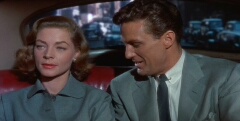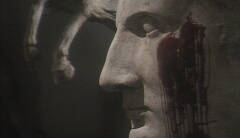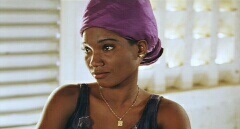Mise-en-scene
The representation of space affects the reading of a film. Depth, proximity, size and proportions of the places and objects in a film can be manipulated through camera placement and lenses, lighting, decor, effectively determining mood or relationships between elements in the diegetic world.
Section 1 — Decor
An important element of “putting in the scene” is décor, the objects contained in and the setting of a scene. Décor can be used to amplify character emotion or the dominant mood of a film. In these shots from 2001: A Space Odyssey(Stanley Kubrick, 1969) the futuristic furniture and reduced color scheme stress the sterility and impersonality of the space station environment. Later, the digital nature of the HAL computer is represented by the repeating patterns and strong geometrical design of the set.
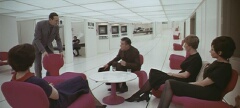
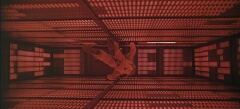
In Senso (Luchino Visconti, Italy, 1954) décor emphasizes the social difference between a wealthy married woman in her richly furnished apartment and her soldier lover in the barren military barracks. Ultimately, she finds the contrast so appalling that she ruins her reputation and financial standing in order to satisfy her lover’s desire for a luxurious lifestyle.
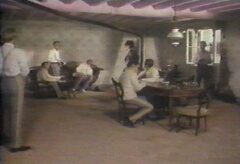
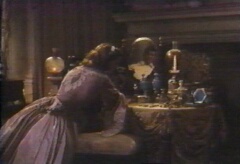
Rear Projection
Usually used to combine foreground action, often actors in conversation, with a background often shot earlier, on location. Rear projection provides an economical way to set films in exotic or dangerous locations without having to transport expensive stars or endure demanding conditions. In some films, the relationship between scenes shot on location and scenes shot using rear projection becomes a signifying pattern. In other films, it’s just cheap . . .
Rear projection is featured extensively in Douglas Sirk’s lush melodrama Written On The Wind (1956). Specifically, almost every car ride is shot in this way, a common feature in Classical Hollywood films, due to the physical restrains of shooting in the studio. In addition, by speeding up the rate of the projected images in the background, or quickly changing its angle, rear projection allows for an impression of speed that involves no real danger.
Even if one of the protagonists of Written On The Wind is a fast-driving alcoholic millionaire (and therefore there are multiple instances of careless driving), rear projection is preferred to stunts both for economic and aesthetic reasons. For example, physical spectacle is not as important in a melodrama as it would be in an action film.
Section 2 — Lighting
The intensity, direction, and quality of lighting have a profound effect on the way an image is perceived. Light affects the way colors are rendered, both in terms of hue and depth, and can focus attention on particular elements of the composition. Much like movement in the cinema, the history of lighting technology is intrinsically linked to the history of film style. Most mainstream films rely on the three-point lighting style, and its genre variations. Other films, for example documentaries and realist cinema, rely on natural light to create a sense of authenticity.
THREE-POINT LIGHTING
The standard lighting scheme for classical narrative cinema. In order to model an actor’s face (or another object) with a sense of depth, light from three directions is used, as in the diagram below. A backlight picks out the subject from its background, a bright key light highlights the object and a fill light from the opposite side ensures that the key light casts only faint shadows. 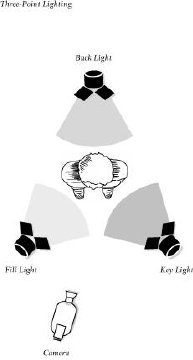
Illustration courtesy of TVCrit.com
These shots from Written On The Wind (Douglas Sirk, 1956) demostrate the classical use of three-point lighting. Laurel Bacall and Rock Hudson are rendered glamorous by the balanced lighting. Compare this to the manipulation of lighting for expressive purposes on the high-key lighting and low-key lighting pages.
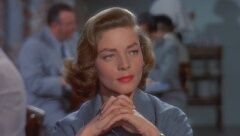 |
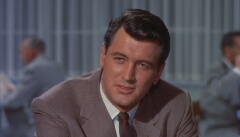 |
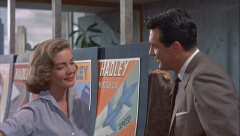 |
HIGH-KEY LIGHTING
A lighting scheme in which the fill light is raised to almost the same level as the key light. This produces images that are usually very bright and that feature few shadows on the principal subjects. This bright image is characteristic of entertainment genres such as musicals and comedies such as Peking Opera Blues (Do Ma Daan, Tsui Hark, Honk Kong, 1986).
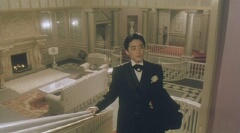 |
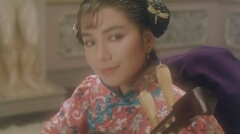 |
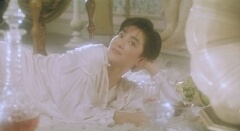 |
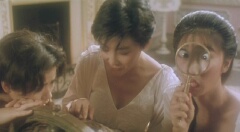 |
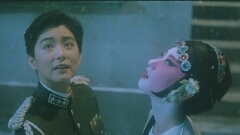 |
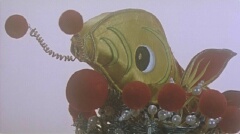 |
LOW-KEY LIGHTING
A lighting scheme that employs very little fill light, creating strong contrasts between the brightest and darkest parts of an image and often creating strong shadows that obscure parts of the principal subjects. This lighting scheme is often associated with “hard-boiled” or suspense genres such as film noir. Here are some examples from Touch of Evil (Orson Welles, 1958.)
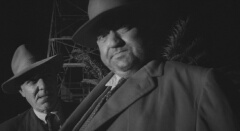 |
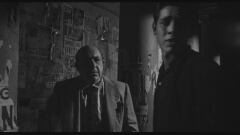 |
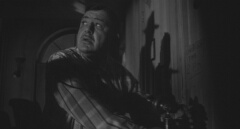 |
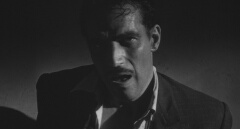 |
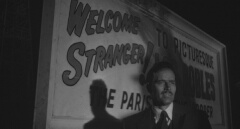 |
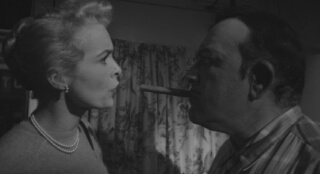 |
Section 3 — Space
The representation of space affects the reading of a film. Depth, proximity, size and proportions of the places and objects in a film can be manipulated through camera placement and lenses, lighting, decor, effectively determining mood or relationships between elements in the diegetic world.
Deep Space
A film utilizes deep space when significant elements of an image are positioned both near to and distant from the camera. For deep space these objects do not have to be in focus, a defining characteristic of deep focus. Staging in deep space is the opposite of staging in shallow space. Deep space is used throughout many Iranian films such as The Color of Paradise (Rang-e Khoda,1999). Director Majid Majidi likes to integrate the characters into their natural surroundings, to map out the actual distances involved between one location and another in order to emphasize just exactly how hard it is for a particular character (especially children) to move from one place to another.

In this composition, Mohammad’s father looks in apprehension at the school where his blind son is visiting.In the far background, Mohammad is playing with his sister and other “normal” children, but his father does not believe Mohammad should try to mingle with them since he could never be their equal, due to his disability. On the other hand, Mohammad enjoys the company of his new friends in the countryside much more than the School for the Blind in Tehran, where he spends most of the year. The distance between the two points of view, as well as the impossibility of communication between Mohammad and his father (the son is too respectful of his father, the father finds his son’s situation too painful), is reflected in the deep use of mise-en-scene.
Frontality
Frontality refers to the staging of elements, often human figures, so that they face the camera square-on. This arrangement is an alternative to oblique staging. Frontal staging is usually avoided by the invisible style of continuity editing, since it supposedly breaks the spectator’s illusion of peeking into a separate world, by having characters look directly into the camera as if they were aware of the viewers’ presence. Some films may go even further and have the characters speak to the camera, in what is called a direct address. Accordingly, frontality is often used in films that are more willing to play with, or openly defy, the distance between the screen and the spectator. In this shot from The Stendhal Syndrome (La Sindrome di Stendhal, Italy, 1996) Dario Argento exploits the iconicity of frontal staging in multiple ways.
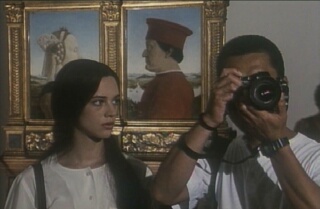
First, he situates his characters on a parallel plane with the famous profile portraits of The Duke of Urbino and his wife by Piero Della Francesca. Then, he flattens the characters by making the space between them and the paintingsshallow with the use of a zoom lens, while keeping all planes in focus. As a reflexive auteur, Argento thus uses frontality to equate his characters with the paintings: both are fictional creations, the product of an artist’s work. As a final self-referential pun, Argento has his Japanese tourist taking a picture of us!
Matte Shot
A process shot in which two photographic images (usually background and foreground) are combined into a single image using an optical printer. Matte shots can be used to add elements to a realistic scene or to create fantasy spaces. In these four examples from Vertigo (1958), director Alfred Hitchcock uses all possible combinations. In the first image, the white belfry is a model added on the foreground of a shot of the roof; in the second image, the sky in the background is clearly a painting, with the purpose of making us believe the scene takes place on a bell tower’s top floor, rather than on the studio’s ground.

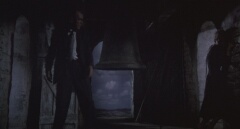
The other two shots belong to the fantasy sequence of Scottie’s dream. In the first one his face is superimposed over a campy “unconscious” image; the last one reverses the process, having a mixture of “real” and matted elements in the background (the roof and the belfry) with the added silhouette in the foreground.
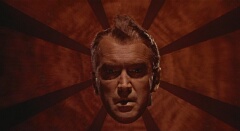
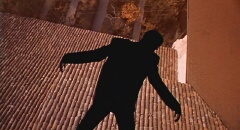
Matte shooting is one of the most common techniques used in studio filmmaking, either for economical reasons (it’s cheaper to shot a picture of the Eiffel tower than to travel to Paris) or because it would be impossible or too dangerous to try to shot in the real space. Sometimes, as when animation and real figures interact, that space may not even exist. In recent years, however, special effects and computer generated images have taken over the function of matte shots.
Offscreen Space
Space that exists in the diegesis but that is not visible in the frame. Offscreen space becomes significant when the viewer’s attention is called to an event or presence in the diegesis that is not visible in the frame. Offscreen space is commonly exploited for suspense in horror and thriller films, such as The Stendhal Syndrome (La Sindrome di Stendhal, Dario Argento, Italy, 1996).
As discussed in the offscreen sound entry, this scene from Life on Earth (La Vie sur Terre, Abderrahmane Sissako, Mauritania, 1998) explores the difficulties of establishing communication in a postcolonial space that still depends on the former colonial master for its technology and even its calendar.
Shallow Space
The opposite of deep space, in shallow space the image is staged with very little depth. The figures in the image occupy the same or closely positioned planes. While the resulting image loses realistic appeal, its flatness enhances its pictorial qualities. Striking graphic patters can be achieved through shallow space. In these frames from My Neighbor Totoro (Tonari No Totoro, Japan, 1988) Miyazaki fills the entire background with a lamp-eyed, grinning catbus. Shallow space creates ambiguity: is the cat brimming with joy at the sisters’ encounter, or is he about to eat them?
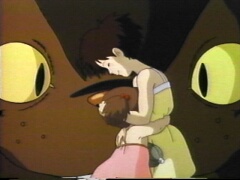

Shallow space can be staged, or it can also be achieved optically, with the use of a telephoto lens.This is particularly useful for creating claustrophic images, since it makes the characters look like they are being crushed against the background.
Section 4 — Costume
Costume simply refers to the clothes that characters wear. Costume in narrative cinema is used to signify character, or advertise particular fashions, or to make clear distinctions between characters.
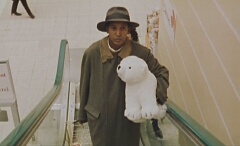
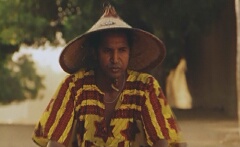
In this example from Life on Earth (La Vie sur Terre, 1998) filmmaker and actor Abderrahmane Sissako uses “similar” costumes (long loose clothes, big hats) to further stress the cultural and psychological implications of a nomadic existence, split between the cold affluence of France and the colorful poverty of Mauritania.
Section 5 — Acting
There is enormous historical and cultural variation in performance styles in the cinema. Early melodramatic styles, clearly indebted to the 19th century theater, gave way in Western cinema to a relatively naturalistic style. There are many alternatives to the dominant style: the kabuki-influenced performances of kyu-geki Japanese period films, the use of non-professional actors in Italian neorealism, the typage of silent Soviet Cinema, the improvisatory practices of directors like John Cassavettes or Eric Rohmer, the slapstick comedy of Laurel and Hardy, or the deadpan of Buster Keaton and Jacques Tatí, not to mention the exuberant histrionics of Bollywood films.
Typage
Typage refers to the selection of actors on the basis that their facial or bodily features readily convey the truth of the character the actor plays. Usually associated with the Soviet Montage school, these filmmakers thought that the life-experience of a non-actor guaranteed the authenticity of their performance when they attempted a dramatic role similar to their real social role. Typage is related to the use of stereotype in communicating the essential qualities of a character. Although current casting practices can no longer be described as typage, the use of performers with experience in the role they played is common to most films, whether they rely on the star system, or on non-professional actors. In Pudovkin’s Storm Over Asia (Potomok Chingis-Khana, USSR, 1928), professional and non-professional actors are used alike. The cast was selected not on terms of their skills or reputation, but on their physical resemblance to the following types:
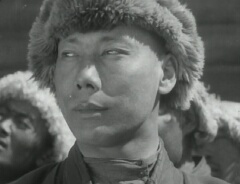
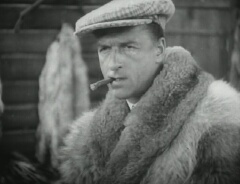
the hero of the Mongol people . . . and the explotative English capitalist
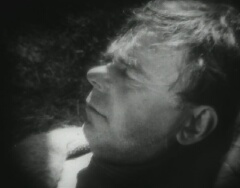
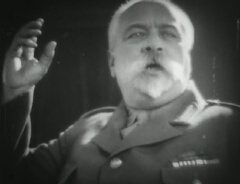
the partisan’s leader, noble and stoic in his deathbed . . . and the pompous and greedy general
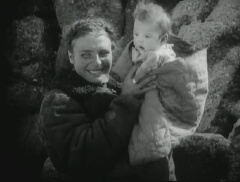
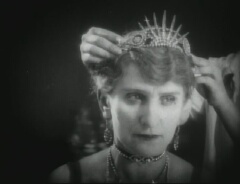
the partisan woman, strong mother and fighter . . . and the decrepit general’s wife with royal ambitions

